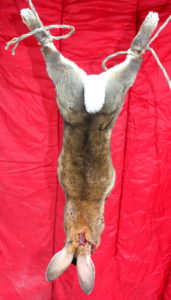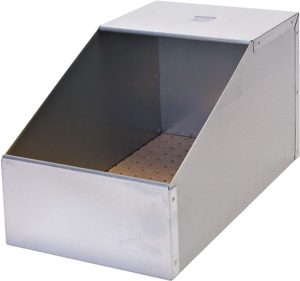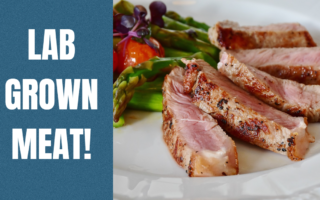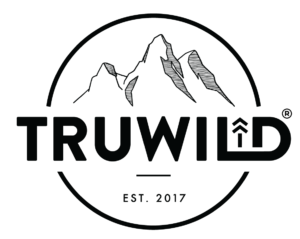If you hunt or raise rabbits for meat, there’s a few steps you’ll need to take to get it to the dinner table. The approximate break down of a 5 lb rabbit is 1/2 lb Pelt, 2 3/4 lb Meat with Bones & Organs, 1 3/4 lb Feet/Intestines/Bladder/Head/Blood/Stomach Contents. Some items your going to need are rope, a good sharp knife, and bags or containers for the organs, guts, feet, etc. These steps include . . .
Dispatching: First thing’s first, you have to put down the animal. I find this to be the most uncomfortable part of the process, in fact, I leave it to my husband to do the dirty work with our meat rabbits. We have respect for these animals lives and put them down in the most humane way possible. Some of the methods for killing a rabbit include . . .
–Bludgeoning: This includes a swift blow to the head. Though humane if done correctly there is room for error if you don’t strike hard enough or in the correct spot.
–Neck Dislocation: Many people use this method claiming that it’s completely humane. My husband and I think differently. Though dislocation means the rabbit stops moving, we feel it simply paralyzes the rabbit, and they still see and feel everything, much like when a person becomes paralyzed. If the brain is intact it can still send signals of what going on to it’s body.
–Slit Throat: This is the most inhumane of the methods I’ll be mentioning, but there’s people out there that use it. The animal is hung upside down, their throat is slit while they are still alive, as they bleed out and eventually die.
–Gun: This is our method of choice and the most humane option in our opinion. The rabbit is set on the ground with gun aimed point blank at the back of the head. At the last moment my husband removes his hand and fires the gun. The brain is destroyed and it leaves a gaping hole for bleeding out afterwards. For safety purposes, my husband does where eye and ear protection, as well as his bullet proof vest.
Skinning: This step is quite easy after the head and front feet or legs have been removed. You’ll start on the back legs by slicing though the skin, and all the way around the ankle. Do your best to just cut through the skin and not through the meat. After slicing around the ankles, make a cut from one ankle to the other, and around the tail. At this point you can start pulling and working the hide down the legs. When you have a good enough grip you can pull the rest of the hide off like a sock.
Gutting: The organs and intestines come out with relative ease, but you’ll want to be extra careful not to nick any of it with your knife to keep the meat clean.
Cleaning: If you’ve done a clean job of cutting up to this point, then you’ll just need to do a simple rinse to remove any hair that stuck to the meat.

Cooking: I keep it simple and just stick the rabbit in a crock pot with water and a little bit of salt to use in later dishes, but there’s many great recipes out there that you can try. Fully cooked and picked clean, I get about 1.25-1.5 lbs of shredded rabbit meat. We use meat sparingly so that lasts us about 3-4 meals.
Butchering Rabbits For Dog Food
In addition to self sufficiency, the main reason we raise meat rabbits is so our dogs have a healthy organic raw source of meat for their raw diets. The following is a breakdown of what a rabbit just under 5 lbs will yield for about a 60 lb dog. I try to break up the carcass and organs as evenly as possible into 4 meals. I currently feed my dog half raw, if he was eating full raw then one rabbit would feed him for 2 days.

Meal Bag #1 = 1 Leg, 1/4 Liver, 1 Kidney, 1 Ear, Stomach (1/2 lb)
Meal Bag #2 = 1 Leg, 1/4 Liver, 1 Kidney, 1 Ear (1/2 lb)
Meal Bag #3 = Back, 1/4 Liver, Left Lung (3/4 lb)
Meal Bag #4 = Rib Cage/Arms, Liver, Right Lung, Heart (3/4 lb)
Treat Bag #5 = Front & Back Feet
Processing your own meat is not for the squeamish, but it’s a good way to know where your food comes from, how it was raised/killed/processed. I’ve seen great health benefits in my dog and again, I know that he’s not getting meat from questionable animals raised in a commercial setting. We do our best to make sure none of the animal goes to waste, including tanning the hides for later sale or use.
Related Post: How To Tan Rabbit Hides (2 Methods)























is it ok to feed a dog the innards of a wild rabbit? also i read that it should be frozen first
With a wild rabbit, you never know what parasites they may have. So yes, it’s best to freeze any wild animal meat for a certain amount of time depending on the type.